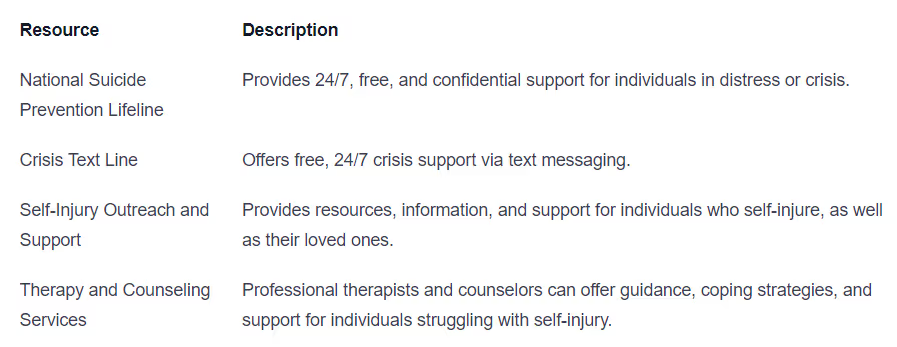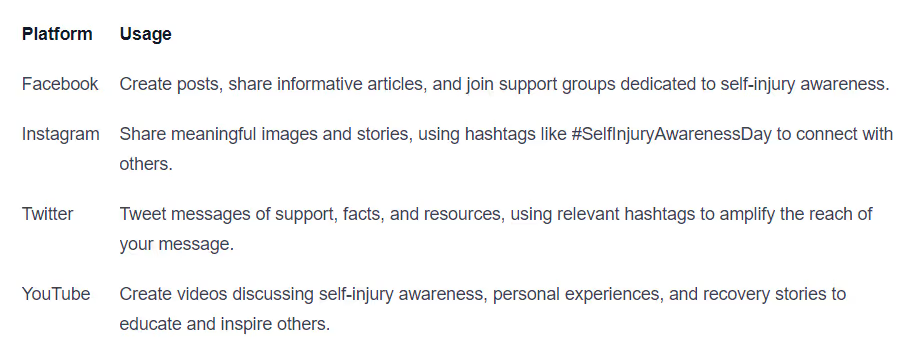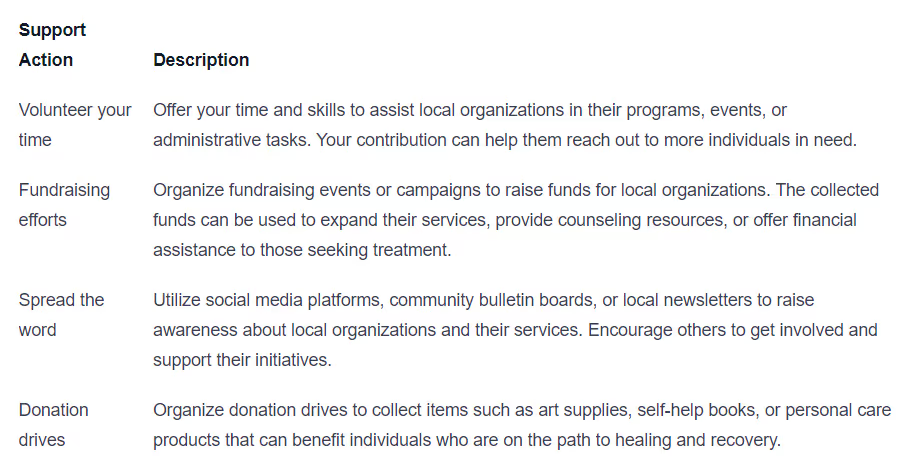Self Injury Awareness Day

Self Injury Awareness Day: Breaking the Silence
Self Injury Awareness Day is an annual observance held on March 1st to raise awareness and understanding about self-injury. It serves as a platform to break the silence surrounding self-harm and provide support to those who are struggling.
What is Self Injury Awareness Day?
Self Injury Awareness Day, also known as SIAD, is a global event that aims to increase awareness and promote compassion for individuals who engage in self-injurious behaviors. It serves as a reminder that self-harm is a serious issue that affects many people, and it encourages open dialogue to reduce stigma and provide support.
The Importance of Observing Self Injury Awareness Day
Observing Self Injury Awareness Day is crucial for several reasons. First and foremost, it helps to bring attention to a topic that is often misunderstood and stigmatized. By shining a light on self-injury, we can debunk misconceptions and educate others about the complexities of this behavior.
Another important aspect of observing Self Injury Awareness Day is the opportunity it provides to offer support and resources to those who are struggling with self-harm. It serves as a reminder that they are not alone and that help is available. Through awareness campaigns, events, and online discussions, individuals can find a sense of community and understanding.
By recognizing Self Injury Awareness Day, we can contribute to breaking the silence surrounding self-injury. It encourages conversations, empathy, and action, ultimately fostering a more supportive and inclusive society.
It's important to note that Self Injury Awareness Day is just the beginning. Awareness and support should extend beyond a single day, with ongoing efforts to educate ourselves and others about self-injury. By coming together, we can create a world where individuals who self-harm feel heard, understood, and supported.
Understanding Self-Injury
In order to create awareness and support individuals who engage in self-injury, it is important to have a clear understanding of what self-injury entails. This section will explore the definition of self-injury and address common misconceptions and stigma associated with it.
What is Self-Injury?
Self-injury, also known as self-harm or self-mutilation, refers to the deliberate act of causing physical harm to oneself as a means of coping with emotional distress or overwhelming feelings. It is important to note that self-injury is not a suicide attempt, but rather a maladaptive coping mechanism used by individuals to alleviate emotional pain or regain a sense of control.
Self-injury can take various forms, including but not limited to:
- Cutting or scratching the skin
- Burning oneself
- Biting or hitting oneself
- Hair pulling (trichotillomania)
- Poisoning oneself (ingesting harmful substances)
It is crucial to approach the topic of self-injury with sensitivity and understanding, recognizing that it is often a manifestation of deeper emotional struggles. Individuals who engage in self-injury may be experiencing feelings of helplessness, emotional numbness, or a need to release tension. It is important to provide non-judgmental support and encourage them to seek professional help.
Common Misconceptions and Stigma
Despite efforts to raise awareness, self-injury is still surrounded by misconceptions and stigmatization. It is essential to debunk these misconceptions in order to create a more empathetic and supportive environment for those affected by self-injury.
One common misconception is that self-injury is attention-seeking behavior. In reality, individuals who engage in self-injury often go to great lengths to hide their wounds or scars, as they may feel shame or fear judgment. It is important to understand that self-injury is a coping mechanism rather than a cry for attention.
Another misconception is that self-injury is solely associated with adolescence. While self-injury often begins during teenage years, it can affect individuals of all ages, genders, and backgrounds. It is not limited to a specific demographic or phase of life.
Stigma surrounding self-injury can lead to further isolation and reluctance to seek help. It is crucial to challenge this stigma and promote open conversations about self-injury, mental health, and emotional well-being. By fostering understanding and empathy, we can create a safer space for individuals to seek support and access appropriate resources.
Understanding self-injury and addressing the misconceptions and stigma associated with it are essential steps in promoting awareness and support for individuals who engage in self-injurious behaviors. By providing accurate information and fostering a compassionate environment, we can work together to break the silence and offer help to those who need it.
Raising Awareness and Support
Raising awareness about self-injury is crucial in breaking the silence and providing support for individuals who struggle with it. By promoting open conversations and providing resources, we can create a safe and understanding environment for those affected by self-injury.
Promoting Open Conversations
Promoting open conversations is essential in fostering understanding and empathy for individuals who self-injure. By creating a safe space for dialogue, we can reduce the stigma surrounding self-injury and encourage individuals to share their experiences.
One way to promote open conversations is by organizing support groups or discussion forums where individuals can express their thoughts, feelings, and concerns. These platforms provide an opportunity for people to connect with others who may have similar experiences, fostering a sense of community and understanding.
It's important to approach these conversations with empathy, active listening, and non-judgment. By creating an environment free from shame and blame, we can encourage individuals to seek support and share their stories without fear of judgment or rejection.
Resources and Support for Individuals
Providing resources and support for individuals who self-injure is essential in helping them navigate their journey towards healing and recovery. There are various organizations, hotlines, and online platforms that offer information, guidance, and assistance to those in need.

These resources play a vital role in helping individuals access the help they need. By sharing information about these resources, we can ensure that individuals who self-injure are aware of the available support systems and can seek appropriate help.
Raising awareness and providing support are essential components of Self Injury Awareness Day. By promoting open conversations and sharing resources, we can create a compassionate and supportive environment that encourages healing and recovery for individuals who self-injure.
Spreading Awareness Online
In the digital age, spreading awareness about important causes has become easier than ever. Self Injury Awareness Day provides an opportunity to utilize the power of social media and online campaigns to reach a wider audience and foster understanding and support.
Utilizing Social Media
Social media platforms offer a vast and accessible audience for spreading awareness about Self Injury Awareness Day. By utilizing social media effectively, individuals can play a significant role in educating others and breaking the stigma surrounding self-injury.

Remember to approach social media with sensitivity and respect, ensuring that your posts provide accurate information and promote empathy and understanding. Engaging with others in a thoughtful and compassionate manner can go a long way in creating a supportive online community.
Participating in Online Campaigns
Online campaigns are a powerful tool for raising awareness and engaging with a broader audience. There are various campaigns specifically dedicated to Self Injury Awareness Day that individuals can actively participate in.

Participating in these campaigns not only raises awareness but also demonstrates solidarity with individuals who have experienced self-injury. It is crucial to be respectful and considerate while sharing your own experiences and supporting others online.
By utilizing social media platforms and participating in online campaigns, individuals can make a significant impact in spreading awareness about self-injury and creating a compassionate and supportive online community. Together, we can break the silence and foster understanding, empathy, and support for those who have experienced self-injury.
Taking Action in Your Community
Self Injury Awareness Day provides an opportunity to take action and make a difference in your community. By organizing events and workshops and supporting local organizations, you can help raise awareness and provide support to individuals who are struggling with self-injury.
Organizing Events and Workshops
Organizing events and workshops is an effective way to bring people together, foster understanding, and educate the community about self-injury. These events can help break the silence surrounding self-injury and provide a safe space for open conversations.
Consider organizing the following events and workshops:

Supporting Local Organizations
Supporting local organizations that focus on mental health and self-injury can make a significant impact in your community. These organizations play a vital role in providing resources, support, and services to individuals struggling with self-injury.
Consider the following ways to support local organizations:

By taking action in your community, you can contribute to breaking the silence surrounding self-injury and provide much-needed support to individuals who are struggling. Organizing events and workshops and supporting local organizations are powerful ways to raise awareness, promote understanding, and foster a compassionate community response to self-injury.
How You Can Make a Difference
Self Injury Awareness Day provides an opportunity to make a positive impact and support individuals who are struggling with self-injury. There are various ways in which you can actively contribute to raising awareness and offering support to those in need.
Educating Yourself and Others
One of the most crucial steps in making a difference is to educate yourself and others about self-injury. By increasing your knowledge and understanding, you can help break down the misconceptions and stigma surrounding this issue.
Take the time to research and learn about self-injury. Understand the reasons behind it, the emotions involved, and the potential underlying mental health conditions. By educating yourself, you can dispel myths and misinformation, fostering a more compassionate and empathetic environment.
In addition to educating yourself, share your knowledge with others. Engage in open and honest conversations about self-injury, promoting understanding and empathy. Encourage your friends, family, and community to learn about this issue and challenge any negative beliefs or judgments they may hold.
Offering Support and Understanding
Support and understanding can go a long way in helping individuals who engage in self-injury. Show empathy and compassion towards those who are struggling, creating a safe and non-judgmental space for them to express their feelings.
Offering support can be as simple as being a good listener. Practice active listening, allowing individuals to share their experiences without interruption or judgment. Validate their emotions and let them know that you are there for them.
Encourage individuals who self-injure to seek professional help if they haven't already done so. Provide them with information about mental health resources and helplines that can offer specialized support. Remember, you are not expected to be a therapist or counselor, but your support can make a significant difference in helping someone seek the help they need.
By educating yourself, spreading awareness, and offering support and understanding, you can contribute to breaking the silence surrounding self-injury. Together, we can create a more compassionate and supportive society, where individuals feel heard, understood, and empowered to seek help on their journey to healing.
Conclusion
In conclusion, Self Injury Awareness Day serves as a reminder of the importance of understanding, empathy, and support for individuals who engage in self-injury. By challenging misconceptions and stigma, promoting open conversations, and providing resources and support, we can create a safe and compassionate environment that encourages healing and recovery.
Raising awareness through online campaigns and taking action in our communities are powerful ways to make a positive impact on those affected by self-injury. By educating ourselves and others, offering support and understanding, we can break the silence surrounding this issue and provide much-needed help to those who need it.
Let us continue to work together towards creating a society that fosters empathy, compassion, and understanding towards mental health issues such as self-injury. Together we can make a difference in the lives of those struggling with self-injurious behaviors.
